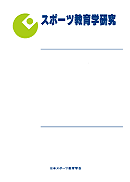
- 2 号 p. 1-
- 1 号 p. 1-
- |<
- <
- 1
- >
- >|
-
中間疾走の疾走動作の比較から西村 三郎, 宮崎 明世, 小林 育斗, 岡出 美則2016 年 36 巻 2 号 p. 1-14
発行日: 2016/11/30
公開日: 2017/04/03
ジャーナル フリーThis study aims to reveal necessary sprint techniques based on the abilities observed in male high school students. The participants were 232 boys. The experiment involved the participants performing a 50 m sprint.
Their sprinting motions were recorded approximately 35 m from the start line with a high-speed video camera using the side view angle. The participants were extracted according to their sprinting velocity by following criteria: the Excellent group (35 students, M + 1SD), Normal group (27 students, M ± 0.25SD), and Poor group (27 students, M−1SD). For evaluating the sprinting motion, joint and segment angles were obtained from the video. These were ankle joint angle, knee joint angle, shank segment angle, thigh segment angle, and body trunk segment angle. The three groups were compared through an analysis of variance to explain the significant differences between them. We identified the techniques each group needed to learn for good sprint ability based on these differences.
The results were as follows:
1) The sprint techniques that the Normal and Poor groups both needed to acquire were swinging the free leg forward with a flexed knee just after takeoff and pulling the thigh of the free leg up.
2) Specific sprint techniques that the Normal group needed to acquire were keeping the knee of the support leg less flexed during the support phase and not leaning the body trunk forward excessively at prophase in support phase.
3) Specific sprint techniques that the Poor group needed to acquire were bringing the shank perpendicular to the ground and landing forefoot.
抄録全体を表示PDF形式でダウンロード (1048K) -
小野 雄大, 友添 秀則, 長島 和幸, 根本 想2016 年 36 巻 2 号 p. 15-30
発行日: 2016/11/30
公開日: 2017/04/03
ジャーナル フリーPrevious research has shown that physical education was introduced to young men’s associations through the strong encouragement of Giichi Tanaka. However, there has not been sufficient research on how Tanaka promoted physical education to young men’s associations or specifically what kind of plans were set forth.Accordingly, this study aims to clarify in detail the concept of promotion of physical education to young men’s associations.
As a result, the following points were clarified:
1) Tanaka positioned youth education in France, Russia and Austria as single-minded military school education and while he recognized its usefulness, he perceived it as negative. Meanwhile, he perceived German youth education favorably as discipline for the body and mind as a prerequisite to activities in the military.
2) In the backdrop of German youth education as a model, Tanaka had a sense of impending crisis with respect to the current state of youth education in Japan which was in a trend of implementing excessive military style education. Based on these points, the education in Tanaka’s concept was, at least, positioned as activities in order to become healthy in terms of both stamina and spirit.
3) The promotion of physical education to the youth was, for Tanaka, keeping in mind the combination of military education and national education, an experiment that required strong and healthy spirits and bodies as a basic prerequisite for the promotion of national power and war potential at time of generalized war as well as an expansion of military training.
抄録全体を表示PDF形式でダウンロード (528K)
-
スポーツ関係組織・機関の取り組みに着目して勝田 隆, 友添 秀則, 竹村 瑞穂, 佐々木 康2016 年 36 巻 2 号 p. 31-48
発行日: 2016/11/30
公開日: 2017/04/03
ジャーナル フリー本研究の目的は、現在のスポーツ界において、スポーツ・インテグリティという用語がどのように捉えられているのかを明らかにすること、また、その用語のもとに展開される実践的取り組みにについて、とくに教育的観点から、問題点を指摘することである。
そのために、まず、現在のスポーツ界において、スポーツ・インテグリティという用語がどのように捉えられているかを整理し、その上で問題点を見出した。
次に、スポーツ・インテグリティを保護・強化をする上で脅威となる要因について整理した。そして、複数のスポーツ団体が実践的に取り組むスポーツ・インテグリティに関するプログラムを、教育的観点から6 つに分類し、問題点について精査した。
考察の結果、本研究において以下の問題点が見出された。
a) スポーツ・インテグリティは、スポーツの文脈だけでなく、教育的・社会的文脈においても語られること。
b) 日本のスポーツ関係者は、大規模イベントの開催国の責任として、この問題に対する教育を啓蒙する必要性について認識し、共有すること。
c) 各組織のリーダーは、スポーツ・インテグリティの脅威に関する共通理解を持ち、これまで以上に共に対処していくことが求められていること。
d)「スポーツ ・インテグリティ」を自分自身に、そして組織や社会に対して問う姿勢として、スポーツそのものを守るための行動変容に不可欠なものと捉えること。
本稿におけるスポーツ・インテグリティに関する考察はまだ序説に位置づくものであり、今後、教育的観点以外の考察を含め、更なる研究が求められる。抄録全体を表示PDF形式でダウンロード (320K)
-
日本ジュニア世代トップレベル選手を対象とした競技サポートから吉田 和人, 山田 耕司, 玉城 将, 加賀 勝2016 年 36 巻 2 号 p. 49-59
発行日: 2016/11/30
公開日: 2017/04/03
ジャーナル フリーThe purpose of this study was to clarify perspectives of teaching and evaluating table tennis services: how to display a player’s movement to his/her opponent. This study was done as a part of a 5-year period of competition support using sport sciences.
The main results and findings were as follows:
1) In table tennis service, when serving a ball far from or near to the net on the receiver’s court, there was often a difference in the first bound placement on the server’s court and the height of the ball-hitting position. Furthermore, when serving a ball to the right or left of the receiver’s court, the direction of the server’s trunk often differed between the courses. These were considered important perspectives for teaching and evaluating table tennis service of top Japanese junior players.
2) The check sheet made in this study to improve the similarity of service movement between different kinds of services was effective for top Japanese junior table tennis players, even for first-time participants. Future subjects of this check sheet would expand to include other coaches and players of varying competitive levels.
3) A comparison between the check sheet of table tennis service movement and table tennis textbooks indicated that the check sheet gave new practicable insights into coaching for improving service: how to display a player’s movement to his/her opponent.
抄録全体を表示PDF形式でダウンロード (763K)
- |<
- <
- 1
- >
- >|